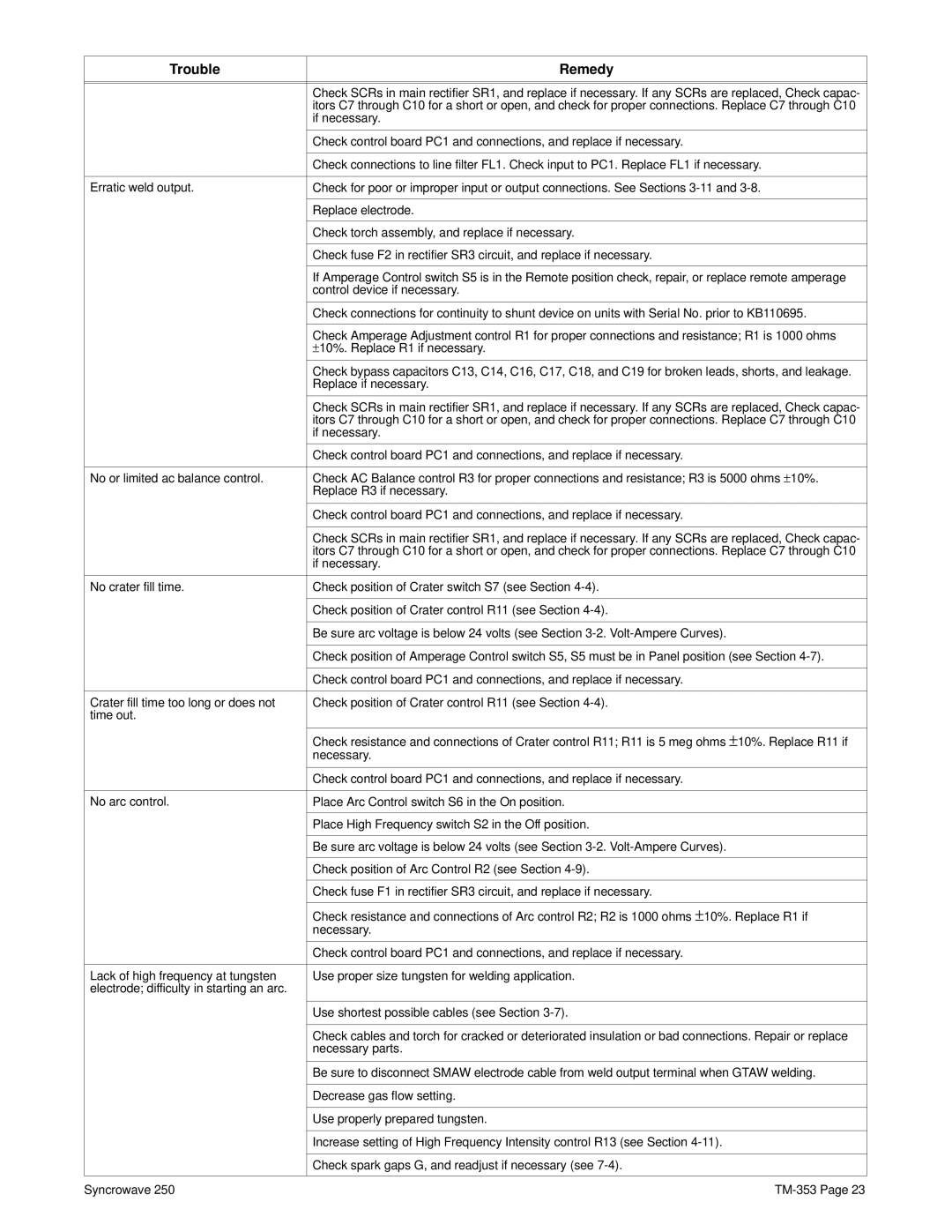Trouble | Remedy |
|
|
|
|
| Check SCRs in main rectifier SR1, and replace if necessary. If any SCRs are replaced, Check capac- |
| itors C7 through C10 for a short or open, and check for proper connections. Replace C7 through C10 |
| if necessary. |
|
|
| Check control board PC1 and connections, and replace if necessary. |
|
|
| Check connections to line filter FL1. Check input to PC1. Replace FL1 if necessary. |
|
|
Erratic weld output. | Check for poor or improper input or output connections. See Sections |
|
|
| Replace electrode. |
|
|
| Check torch assembly, and replace if necessary. |
|
|
| Check fuse F2 in rectifier SR3 circuit, and replace if necessary. |
|
|
| If Amperage Control switch S5 is in the Remote position check, repair, or replace remote amperage |
| control device if necessary. |
|
|
| Check connections for continuity to shunt device on units with Serial No. prior to KB110695. |
|
|
| Check Amperage Adjustment control R1 for proper connections and resistance; R1 is 1000 ohms |
| ± 10%. Replace R1 if necessary. |
|
|
| Check bypass capacitors C13, C14, C16, C17, C18, and C19 for broken leads, shorts, and leakage. |
| Replace if necessary. |
|
|
| Check SCRs in main rectifier SR1, and replace if necessary. If any SCRs are replaced, Check capac- |
| itors C7 through C10 for a short or open, and check for proper connections. Replace C7 through C10 |
| if necessary. |
|
|
| Check control board PC1 and connections, and replace if necessary. |
|
|
No or limited ac balance control. | Check AC Balance control R3 for proper connections and resistance; R3 is 5000 ohms ± 10%. |
| Replace R3 if necessary. |
|
|
| Check control board PC1 and connections, and replace if necessary. |
|
|
| Check SCRs in main rectifier SR1, and replace if necessary. If any SCRs are replaced, Check capac- |
| itors C7 through C10 for a short or open, and check for proper connections. Replace C7 through C10 |
| if necessary. |
|
|
No crater fill time. | Check position of Crater switch S7 (see Section |
|
|
| Check position of Crater control R11 (see Section |
|
|
| Be sure arc voltage is below 24 volts (see Section |
|
|
| Check position of Amperage Control switch S5, S5 must be in Panel position (see Section |
|
|
| Check control board PC1 and connections, and replace if necessary. |
|
|
Crater fill time too long or does not | Check position of Crater control R11 (see Section |
time out. |
|
|
|
| Check resistance and connections of Crater control R11; R11 is 5 meg ohms ± 10%. Replace R11 if |
| necessary. |
|
|
| Check control board PC1 and connections, and replace if necessary. |
|
|
No arc control. | Place Arc Control switch S6 in the On position. |
|
|
| Place High Frequency switch S2 in the Off position. |
|
|
| Be sure arc voltage is below 24 volts (see Section |
|
|
| Check position of Arc Control R2 (see Section |
|
|
| Check fuse F1 in rectifier SR3 circuit, and replace if necessary. |
|
|
| Check resistance and connections of Arc control R2; R2 is 1000 ohms ± 10%. Replace R1 if |
| necessary. |
|
|
| Check control board PC1 and connections, and replace if necessary. |
|
|
Lack of high frequency at tungsten | Use proper size tungsten for welding application. |
electrode; difficulty in starting an arc. |
|
|
|
| Use shortest possible cables (see Section |
|
|
| Check cables and torch for cracked or deteriorated insulation or bad connections. Repair or replace |
| necessary parts. |
|
|
| Be sure to disconnect SMAW electrode cable from weld output terminal when GTAW welding. |
|
|
| Decrease gas flow setting. |
|
|
| Use properly prepared tungsten. |
|
|
| Increase setting of High Frequency Intensity control R13 (see Section |
|
|
| Check spark gaps G, and readjust if necessary (see |
|
|
Syncrowave 250 |
